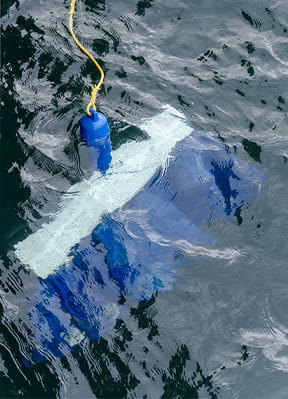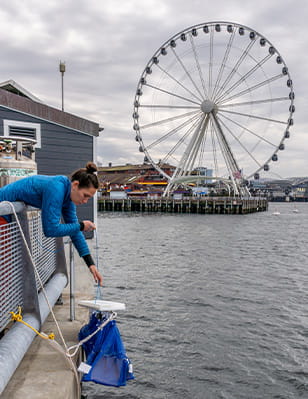
One of the main factors impacting ocean health? People. The Seattle Aquarium’s marine debris and microplastics researchers study anthropogenic (human-caused) debris in water across space and time.
They collect different sample types to provide a holistic look at microplastic and debris in our local waters. Our researchers monitor:
- Time-related changes in microplastics with water samples collected from our intake pump 30 feet beneath our pier every other week.
- How well our filters are removing this marine pollution from intake waters to deliver cleaner waters to the animals in our care.
- Vertical transportation of debris in the water column (meaning seawater at various depths). To measure this, we deploy a plankton net over the side of the pier for 24 hours every other week.



Testing alternatives to plastics
In addition to the monitoring described above, our Clean Seas research program participates in efforts to develop alternatives to single-use plastic film that are safer for the environment and marine organisms.
Single-use plastic films used for packaging, produce wrap and to-go bags make up five million metric tons, or about 46%, of all ocean plastic. Replacing plastic films with more sustainable, nontoxic alternatives is an essential step toward “turning off the tap” of our plastic film pollution problem.
In 2022, we were selected as one of two testing sites for the TOM FORD Plastic Innovation Prize (PIP) powered by Lonely Whale. Using a variety of scientific quantitative (measured) and qualitative (assessed) tests, we exposed plastic films and ecological alternative samples to Salish Sea environmental conditions for eight months at the surface and at 10 meters deep, removing films from the water at consistent intervals to determine how they degrade in temperate environments. Samples were also placed through a gray whale stomach to discover any possible effects upon marine life that swallowed the material.
Not to worry, it was a simulated whale stomach. No animals were tested or harmed.
Read our research papers
Curious to dive deeper into our foundational research? Below are selected academic and professional journal articles we’ve published over the years. (Note that some papers require subscriptions.)


